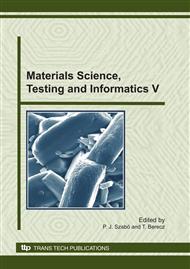p.25
p.31
p.37
p.43
p.49
p.55
p.61
p.67
p.73
Fatigue Crack Growth Examinations on Austenitic Stainless Steel in Corrosive Environment and at Elevated Temperature
Abstract:
There are different documents and standards containing fatigue crack propagation limit or design curves and rules for the prediction of crack growth. The background of the curves and the calculations consist of two basic parts: statistical analysis of numerous experiments and a fatigue crack propagation law. The research work aimed to measure basic data for limit curves on austenitic stainless steel, in corrosive environment and at elevated temperatures, and to determine the design curves based on statistical analysis of measured data and a fatigue crack propagation law. Experiments were performed on modified CT specimens, in water solution and at two different temperatures. The fatigue crack growth tests were executed by constant load amplitude method. In order to study the hold time effect, fatigue crack growth tests were terminated and hold time period was applied. It can be concluded that the modified CT specimens are suitable for fatigue crack growth tests in corrosive environment; the fatigue crack propagation characteristics are different at different testing temperatures; and stable crack propagation and/or crack tip blunting can be detected during the hold time period at the used higher testing temperature.
Info:
Periodical:
Pages:
49-54
Citation:
Online since:
September 2010
Authors:
Price:
Сopyright:
© 2010 Trans Tech Publications Ltd. All Rights Reserved
Share:
Citation:


